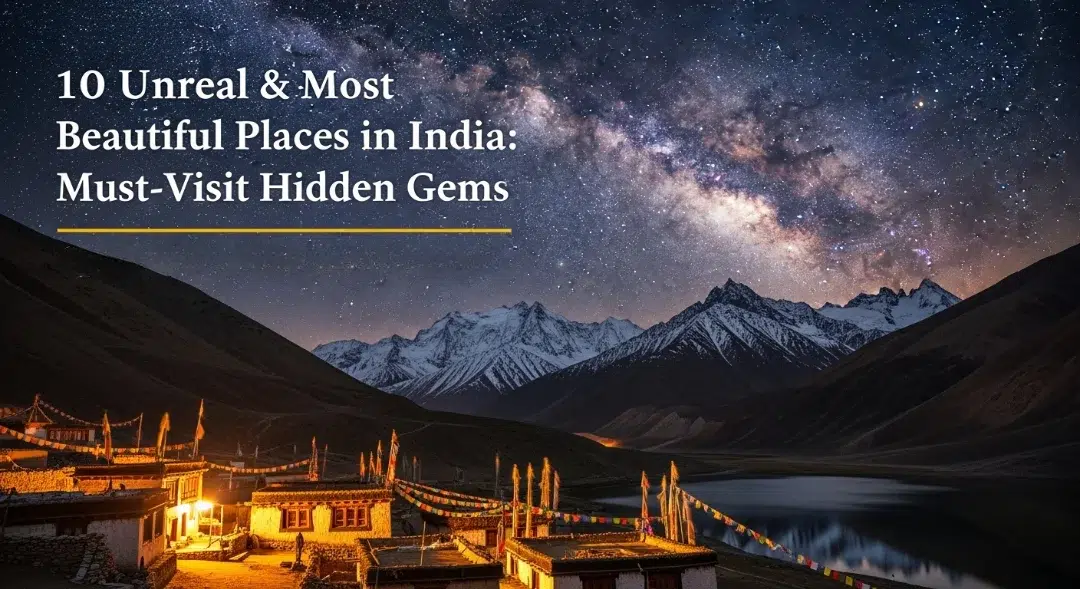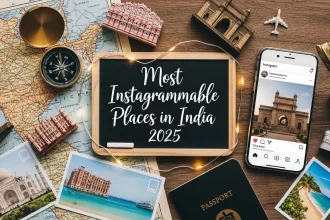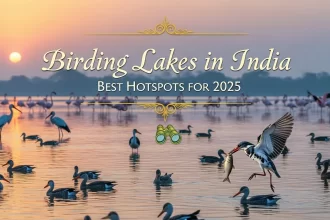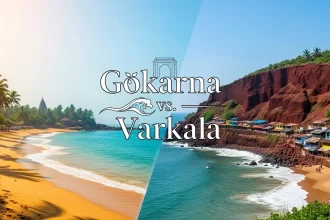Introduction: Why These 10 Places Are “Unreal”
India is a traveler’s paradise, but the sheer volume of tourists often means the most advertised destinations lose their tranquility. For those seeking true escape and genuine adventure, the real treasures lie in the shadows. This curated list explores 10 unreal & most beautiful places in India that promise an experience far beyond the ordinary. This is for the traveler seeking isolation, authenticity, and visual splendor away from the noise. Each location here is a true Hidden Gem, offering breathtaking views that seem to belong to another world entirely. This article acts as a comprehensive guide for those ready to delve into the country’s most unique travel destinations, ensuring that your next trip is transformative and unforgettable.
The 10 Hidden Gems of Incredible India
1. Spiti Valley, Himachal Pradesh
Spiti is an isolated, high-altitude cold desert nestled deep in the Himalayas. Often referred to as “Little Tibet,” its topography is defined by barren, majestic mountains and turquoise rivers that carve their way through the desolate terrain. The air is crisp, the silence is profound, and the vast, open skies make you feel insignificantly small. It truly is one of India’s most dramatic photogenic spots.
- Why It’s a Hidden Gem: Its remote location and challenging accessibility (often cut off by snow for half the year) keep it off the map for most tourists. It remains a precious Lesser-known spot where ancient Buddhist monasteries like Key and Dhankar cling impossibly to the cliffside. The culture here is centuries old, offering pure, unadulterated Himalayan spirituality.
- Planning Your Visit: The best time to visit is typically from June to October when the high mountain passes (Rohtang and Kunzum) are open. The nearest major access point is through Manali or Shimla.
- Pro-Tip: Plan for at least seven days to acclimatize properly to the altitude and fully enjoy the breathtaking views.
2. Loktak Lake, Manipur
Loktak Lake is often cited as a Natural wonder of India, and for good reason. It is the largest freshwater lake in Northeast India, famous for its phumdis—floating masses of vegetation, soil, and organic matter. From above, the lake looks like a giant, vibrant green mosaic. The visual effect of these circular, habitable islands is one of the most breathtaking views you will ever witness.
- Why It’s a Hidden Gem: This is one of the ultimate Hidden Gems of Northeast India, where tourism is still in its nascent stage. It is home to the world’s only floating national park, Keibul Lamjao, which protects the endangered Sangai (Manipur brow-antlered deer). The local fishing communities live on floating huts called phumshang, making it a unique example of human-nature harmony.
- Planning Your Visit: The best time to visit is during the winter months, from October to March. It is about 50 km from Imphal, the capital of Manipur.
- Pro-Tip: Take a local boat ride during sunrise to truly appreciate the tranquility and capture stunning images of this unique ecosystem.
3. Rann of Kutch, Gujarat
Imagine a vast, seemingly endless expanse of blinding white salt desert stretching to the horizon. The Great Rann of Kutch is a surreal landscape, where the flat, crystalline ground reflects the light of the sun and the moon, creating incredibly scenic landscapes. During a full moon night, the Rann transforms into a magical, silvery stage, offering an almost otherworldly breathtaking view.
- Why It’s a Hidden Gem: Most of the year, the Rann is partially submerged. It only becomes a white desert after the monsoon waters recede, limiting its accessibility. While the annual Rann Utsav draws crowds, the surrounding areas and the Little Rann remain Lesser-known spots, perfect for spotting the Indian wild ass and experiencing local Kutchi culture.
- Planning Your Visit: Visit between November and February. Special permits are required to enter the White Rann, which can be obtained online or at the check post.
- Pro-Tip: Carry good sunglasses and a hat; the glare from the salt crystals is intense, and the area is truly one of the best photogenic spots in the state.
4. Mawlynnong & Dawki, Meghalaya
Mawlynnong, often tagged as Asia’s Cleanest Village, is a stunning contrast of pristine surroundings and lush greenery. Nearby, Dawki offers a river so clear that boats seem to float on glass, providing one of the most delightful breathtaking views of the water and riverbed below. The natural wonders here include the spectacular Living Root Bridges, a true marvel of bio-engineering.
- Why It’s a Hidden Gem: This region represents the future of sustainable tourism. The cleanliness and organization of the hidden villages of the Khasi community are remarkable. The remote location near the Bangladesh border makes it a Hidden Gem that offers travelers a blend of community tourism and unmatched natural beauty, far superior to the usual Top tourist attractions.
- Planning Your Visit: October to April is the best season. Mawlynnong and Dawki are easily accessible from Shillong.
- Pro-Tip: Take a moment to walk the trails and truly absorb the Flora and fauna; the air quality and the vivid green moss are part of the unreal atmosphere.
5. Gokarna, Karnataka
Unlike its northern neighbors, Gokarna maintains a unique blend of pilgrimage and relaxation. The beaches here are famous for their distinct shapes, such as Om Beach, which naturally forms the auspicious Om symbol. Climbing the hillocks surrounding the beaches offers a spellbinding, breathtaking view of the entire coastline, perfect for peaceful contemplation.
- Why It’s a Hidden Gem: While it has gained popularity, Gokarna retains its title as an Offbeat travel destination compared to the mass appeal of Goa. Its atmosphere is laid-back, spiritual, and perfect for a digital detox. It attracts travelers who seek quiet beaches and local temple culture rather than nightlife and crowds.
- Planning Your Visit: The best time is October to March. The town is well-connected by train.
- Pro-Tip: Hike between Kudle Beach and Half Moon Beach to discover small coves and get the best wide-angle shots of the scenic landscapes.
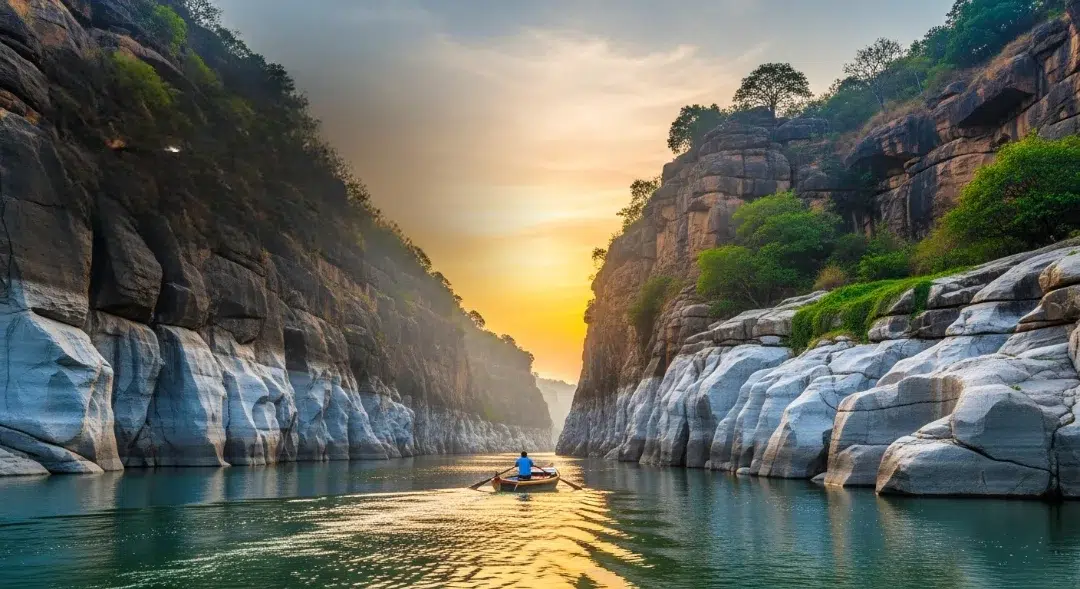
6. Zanskar Valley, Ladakh
Zanskar is a formidable, isolated valley characterized by steep, inaccessible cliffs and the mighty Zanskar River. The landscape changes dramatically with the seasons; in winter, the river freezes, creating the famous Chadar Trek. This extreme isolation provides some of the most spectacular and humbling breathtaking views in the entire country, truly challenging what travelers think of as India.
- Why It’s a Hidden Gem: Zanskar is a difficult Hidden Gem to access, requiring determination and planning. The journey itself is an adventure, passing through high mountain passes and desolate stretches. Its unique Buddhist culture and the simple life of its inhabitants make it one of the Must-see sights for serious explorers, offering a genuine look at ancient Himalayan life.
- Planning Your Visit: Road access is limited to a few summer months (July to September). Accommodation often involves basic guesthouses or homestays.
- Pro-Tip: Check the road status before you leave; this is an extreme location where meticulous preparation is essential.
7. Hampi, Karnataka
Hampi is a UNESCO World Heritage Site, but its atmosphere feels distinctly unreal. It is defined by thousands of monolithic granite boulders scattered across a dramatically undulating terrain, interspersed with magnificent ancient ruins of the Vijayanagara Empire. Watching the sunrise from Matanga Hill, with the boulders glowing pink, provides a mesmerizing and breathtaking view.
- Why It’s a Hidden Gem: While the main temples are busy, the sheer size of the site allows travelers to discover countless lesser-known spots forgotten temples, ancient canals, and quiet ferry crossings—that few tourists bother to find. This vast open-air museum is a testament to India’s glorious past, offering a quiet, contemplative experience that feels like walking through history.
- Planning Your Visit: The cooler months from October to March are ideal. Hospet is the nearest train station.
- Pro-Tip: Rent a bicycle or scooter to explore the extensive ruins on the other side of the Tungabhadra River, maximizing your ability to find photogenic spots.
8. Chitkul, Himachal Pradesh
Chitkul is often cited as the last inhabited village on the Indo-Tibetan border accessible to civilians, set amidst the stunning Kinnaur Valley. The Baspa River flows fiercely beside the quaint wooden houses, surrounded by snow-dusted peaks. This pristine setting provides a pure, unpolluted, and breathtaking view of the inner Himalayas.
- Why It’s a Hidden Gem: The journey to Chitkul itself is an Offbeat travel experience, involving crossing treacherous mountain roads, which naturally filters the number of visitors. The remoteness has helped preserve the unique architecture and culture of the Kinnauri people. For those who love mountains, this is one of the best sights in the country, a peaceful end-of-the-road haven.
- Planning Your Visit: Road access is from May to October. You must register at the check post before entering the village.
- Pro-Tip: The local potatoes are famous! Engage with the locals to understand the challenges of living in such a beautifully remote and Hidden Gem.
9. Valley of Flowers, Uttarakhand
The Valley of Flowers is a high-altitude meadow nestled in the West Himalayan ranges, famous for its endemic alpine flora and fauna. For a brief season, the entire valley transforms into a canvas of color as thousands of species of wildflowers bloom. The breathtaking views of the colorful carpet against the backdrop of snowy mountains makes it a spectacular Natural wonder of India.
- Why It’s a Hidden Gem: The valley is only accessible via a challenging trek and is open for just a few months (typically July to September) when the snow melts. This restriction ensures that it remains protected and untainted by mass tourism, making it a powerful example of a preserved Lesser-known spot. Its beauty is fleeting and precious, requiring effort to experience.
- Planning Your Visit: Entry to the national park requires a permit. The base camp is Govindghat, followed by a trek to Ghangaria.
- Pro-Tip: Timing is crucial; visit in late July or early August for the maximum bloom density and the most vibrant colors.
10. Athirappilly Falls, Kerala
Often referred to as “The Niagara of India,” the Athirappilly Falls are massive, cascading waterfalls that plunge through the jungle of the Sholayar Reserve Forest. The sight and sound of the water crashing across three distinct columns is an imposing and magnificent scenic landscape. The misty spray and surrounding dense, tropical jungle create an almost cinematic breathtaking view.
- Why It’s a Hidden Gem: While in Kerala, most tourists head straight for the backwaters or coastal areas, overlooking this phenomenal inland waterfall. It is a stunning Hidden Gem situated near the pristine jungle, which is home to various species of hornbills and other endemic wildlife, adding an ecological layer to the experience.
- Planning Your Visit: The monsoon and post-monsoon period (June to October) offers the highest water flow and the most dramatic view. The falls are about 60 km from Kochi International Airport.
- Pro-Tip: Walk down to the bottom of the falls for a truly immersive perspective of the sheer scale and power of the water.
Must Read: 5 Largest Forts in India: A 2025 Guide to Must-Visit Historical Marvels
Why Visit Unreal Places in India
Most travelers think of Goa, Shimla, or Jaipur when planning a trip. While these spots are popular, the real magic lies in those secret corners untouched valleys, shimmering lakes, and ancient cultural landscapes that feel like stepping into another world.
Exploring these surreal destinations in India means discovering unspoiled beauty, experiencing warm hospitality in traditional communities, and walking through dreamlike landscapes in India that remain etched in memory forever. Each destination here is not only visually striking but also deeply tied to cultural and natural heritage, making them some of the most beautiful places in India you must explore.
Pro Tips for Offbeat Travel
Successfully navigating these Most Beautiful Places in India requires the right preparation. Travelers looking to experience Offbeat travel must prioritize planning and responsible tourism. Always research local customs and transportation methods; for instance, the road conditions in the Himalayas differ vastly from the logistics required for island travel.
Embrace the unpredictability that comes with visiting Lesser-known spots, as this often leads to the most rewarding experiences. A flexible mindset and respect for the local environment are key to ensuring these Hidden Gems remain pristine for future generations. Exploring the depth of Incredible India is about more than just checking off locations; it’s about immersion and discovery.
Must Read: Exploring 10 Natural Wonders of India That Will Leave You Breathless
Conclusion: Starting Your Journey
This journey into the heart of India’s remote corners proves that the most rewarding experiences are found off the well-trodden path. The 10 Unreal & Most Beautiful Places in India detailed here represent the pinnacle of natural and historical splendor, offering sights and sounds unmatched by conventional tourism. Choosing any of these Hidden Gems means choosing a trip that is rich in culture, adventure, and unforgettable breathtaking views. Now is the time to start planning your exploration of the vast, diverse, and truly Incredible India.
Must Read: Top 6 Adventure Destinations in India for Every Thrill-Seeker
FAQs (Frequently Asked Questions)
Q1. What is the best time to visit these “unreal” hidden gems in India?
Ans: The best time generally depends on the region: October to March is ideal for Southern and Coastal Hidden Gems (like Hampi and Gokarna), while June to September (excluding peak monsoon) is best for high-altitude locations like Spiti Valley and Zanskar.
Q2. Are these beautiful offbeat places safe for solo women travelers?
Ans: Yes, most of these lesser-known spots are generally safe, especially those centered around community tourism (like Mawlynnong) or popular trekking circuits. However, always prioritize local knowledge, hire registered guides for remote treks, and research the local environment before engaging in Offbeat travel.
Q3. Do I need special permits to visit remote locations like Spiti Valley or Dawki?
Ans: Yes, locations near international borders, such as Spiti Valley (Inner Line Permit) and parts of the Northeast (like Arunachal Pradesh or Nagaland), often require an Inner Line Permit (ILP) or special permission for tourists, especially foreigners. Always check specific state requirements before starting your journey.
Q4. Are these Most Beautiful Places in India expensive compared to major cities?
Ans: While local accommodation and food in these hidden villages are often cheaper than in metro cities, the overall cost can be high due to challenging logistics. Transportation to and from these remote areas, especially hiring private vehicles or flights, can significantly increase the total budget for your unique travel destinations.
Q5. How difficult is the travel to these Hidden Gems?
Ans: Many Hidden Gems are inherently difficult to reach, often requiring long drives, trekking, or specialized transportation (like the Zanskar trek). The difficulty is part of what keeps the locations pristine and prevents them from becoming overcrowded top tourist attractions.
Q6. What makes a place a “Hidden Gem” in India’s travel scene?
Ans: location is considered a Hidden Gem when it offers breathtaking views or cultural immersion but remains largely untouched by mass tourism. This status is typically due to its remote location, limited accessibility, or lack of aggressive commercial promotion, preserving its tranquil and authentic atmosphere.
Thank you for trusting Outdoorkeeda as your guide for your travel needs.

